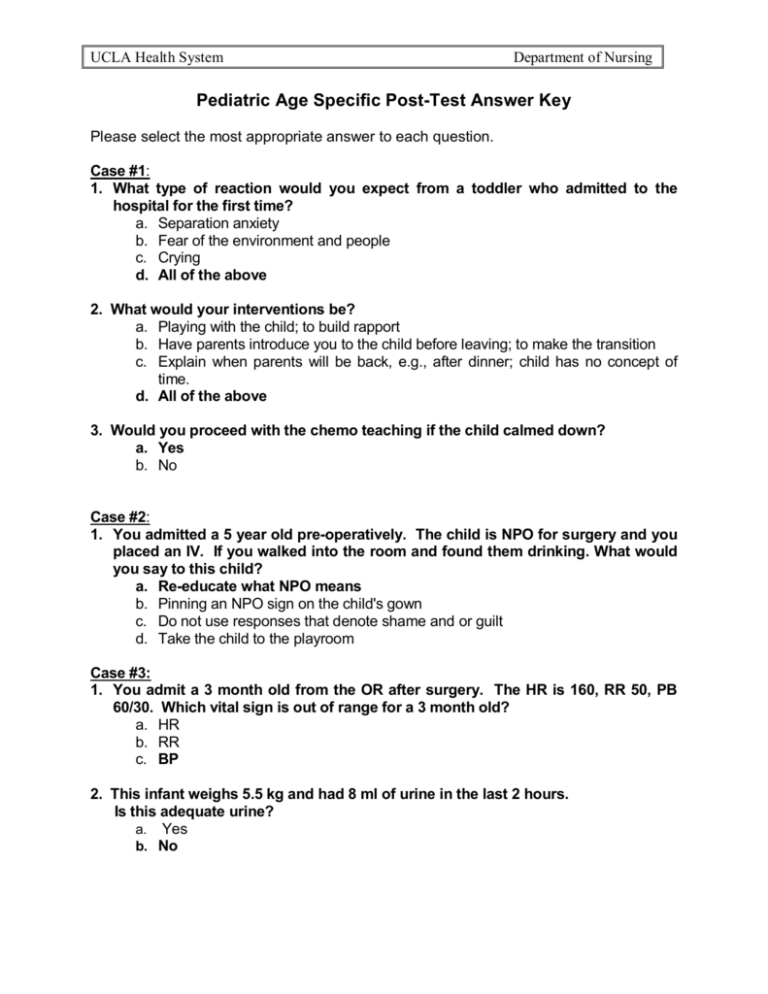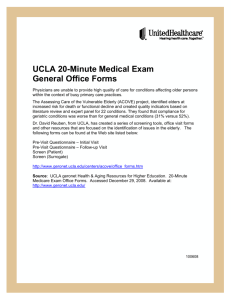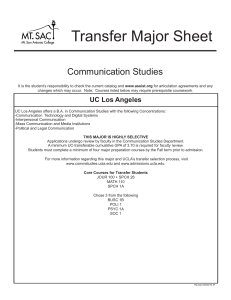Pediatric Age Specific Post
advertisement

UCLA Health System Department of Nursing Pediatric Age Specific Post-Test Answer Key Please select the most appropriate answer to each question. Case #1: 1. What type of reaction would you expect from a toddler who admitted to the hospital for the first time? a. Separation anxiety b. Fear of the environment and people c. Crying d. All of the above 2. What would your interventions be? a. Playing with the child; to build rapport b. Have parents introduce you to the child before leaving; to make the transition c. Explain when parents will be back, e.g., after dinner; child has no concept of time. d. All of the above 3. Would you proceed with the chemo teaching if the child calmed down? a. Yes b. No Case #2: 1. You admitted a 5 year old pre-operatively. The child is NPO for surgery and you placed an IV. If you walked into the room and found them drinking. What would you say to this child? a. Re-educate what NPO means b. Pinning an NPO sign on the child's gown c. Do not use responses that denote shame and or guilt d. Take the child to the playroom Case #3: 1. You admit a 3 month old from the OR after surgery. The HR is 160, RR 50, PB 60/30. Which vital sign is out of range for a 3 month old? a. HR b. RR c. BP 2. This infant weighs 5.5 kg and had 8 ml of urine in the last 2 hours. Is this adequate urine? a. Yes b. No UCLA Health System Department of Nursing 3. This infant has an IV going at 40 ml/hr, is this providing the correct hourly maintenance fluid? CCPs omit this question a. Yes b. No Pediatric Emergency Care Exercise:—CCPs omit these questions 1. Most pediatric patients require emergency care due to: a. Respiratory distress b. Cardiac arrest 2. True or False. Start compressions prior to assessing for airway or ventilation. 3. Compression depth for an infant should be a. 1/3 AP depth and 1 ½ inch b. 1/2 AP depth and 2 inch c. 1/4 AP depth and 1 inch 4. For children and infants, aim to have a rate of compressions of at least _____ per minute. a. 60bpm b. 80bpm c. 100bpm 5. When Bag/Valve mask ventilation is not being effective, what do you need to check: a. Mask b. Bag c. Oxygen hook up 6. The first emergency drug of choice is: a. Atropine b. Dopamine c. Epinephrine 7. A peripheral IV cannot be secured. What next site would you try? a. Scalp b. Intraosseous c. Antecubital Revised 8/11: Grace Sund, RN, MSN, CPNP, CNS UCLA Health System Adolescent Age Specific Answer Key 1. You admit a14 year old accomplished school athlete, pre-operatively for repair of 2 knee tendons. What issues will the teen have? a. Issues about body image b. Loss of relationship with peers c. Loss of identity-no longer a star. d. All of the above 2. How would you accomplish pre-op teaching with this teen? a. You would do pre-op teaching and use show and tell or abstract methods. b. Give information. Assess his level of understanding and emotional maturity. c. Allow time for questions and be available to discuss concerns. d. All of the above Revised 6/10 Theresa Kirkpatrick, RN, MSN, CCRN, CPNP Kateri Tobias, RN, BSN UCLA Health System Adult Age Specific Answer Key Please select the most appropriate answer to each question. 1. At which stage of adulthood are the adult goals most clear? a. Young (20 to 30) b. Middle (30 to 45) c. Later (45 to 65) 2. Which of the following are characteristics of Mid-life Crisis? a. increase in leisure time b. change in orientation from time lived to time left to live c. conflict between career and family goals d. acceptance of the discrepancy between life goals and probable attainment A&B A, B, and D C&D B&D Revised: 6/10 Rebecca Heffler, RN, MN Betty Dodson, RN, MSN, CNS UCLA Health System Geriatric Age Specific Answer Key 1. Pain is a normal part of aging, and it is something one must live with. a. True b. False 2. A non-diabetic older patient may have an increased blood sugar because: a. There is reduced sensitivity to circulating insulin. b. Older people eat too many sweets. c. There is a decreased reabsorption of glucose by the kidneys. d. a and c e. All of the above 3. Sensory changes in the elderly can make a foreign environment a dangerous place to be. a. True b. False 4. Chances of aspiration are increased in the elderly. Mark the incorrect statement. a. Esophageal motility is slowed, and the esophagus may become dilated. b. Elderly patients should be up in a chair at mealtime whenever possible. c. If the patient cannot be out of bed, in a chair, then he could rest however he would like in bed, as long as he can reach his food to eat. d. Patients with NG and G-Tube feedings should have head of bed elevated, or be out of bed in a chair, until at least 30 minutes after completion of the feeding. e. All of the above. 5. Confusion in the elderly is frequently one of the first signs of infection. a. True b. False UCLA Health System 6. Mr. Smith, an 80 year old male, is admitted with pneumonia. He has been independent in his home with his daughter and her family. He has no remarkable health history, except for hernia repair when he was 56. Mr. Smith’s wife of 59 years died 6 months ago. It was at that time, he moved from his lifelong home in Gorman into his daughter’s home in Los Angeles. Which of the following might you expect to have contributed to the pneumonia? a. Incomplete lung expansion b. Insufficient inflation at bases c. Decreased Ability to expel secretions d. Inefficient cough e. All of the above 7. On admission, which of the following information would be helpful to get? a. Living Arrangements b. Advanced Directive c. Regular Medications d. Functional Status e. All of the above 8. There is a 50% decrease in renal blood flow and glomerular filtration rate in the elderly. Therefore, drugs excreted by the kidneys may stay in the body longer. a. True b. False 9. On Mr. Smith’s first night at the hospital, he has an episode of acute confusion. Possible causes are: a. Decreased O2 saturation b. Hospitalization itself c. Infection d. Noise at the nurse’s station e. All of the above 9. Mr. Smith will need two weeks of IV antibiotics. It was decided they could be managed at home by his daughter and the visiting nurses. As discharge planning continues, the needs of both Mr. Smith and his family must be considered. a. True b. False Revised 6/10 Anila Ladhani, RN, MSN, CNS


